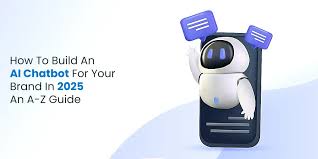AI chatbots have transitioned from novelty tools to essential business assets. In 2025, organizations across industries are turning to AI-powered bots to automate customer service, streamline operations, generate leads, and provide round-the-clock support.
If you’re planning to build a chatbot this year, the process has never been more accessible. With low-code platforms, powerful APIs, and large language models like GPT-4.5, even non-technical teams can create intelligent, conversational agents.
This step-by-step guide will walk you through everything you need to know about how to build an AI chatbot in 2025—from initial planning to final deployment.
Why Build an AI Chatbot in 2025?
Before diving into the process, it’s important to understand the value AI chatbots bring in the current landscape:
- Over 90% of businesses now use some form of conversational automation.
- AI chatbots reduce response time by up to 80%, improving customer experience.
- Generative AI models now enable bots to handle complex, nuanced conversations.
Whether you want to improve customer support, assist internal teams, or drive conversions, a well-developed chatbot is a strategic investment.
Step 1: Define the Chatbot’s Purpose
Every effective chatbot begins with a clear objective. Determine what your chatbot should do:
- Answer FAQs and support queries
- Guide users through products or services
- Generate and qualify leads
- Schedule appointments or process orders
- Assist internal staff (HR, IT, onboarding, etc.)
Start with a focused use case and expand functionality later as needed.
Step 2: Choose the Right Type of Chatbot
There are three common chatbot types in 2025:
- Rule-based bots – Operate using predefined flows and menus.
- AI-powered bots – Understand natural language using NLP and intent recognition.
- Generative AI bots – Use models like GPT-4.5 to generate dynamic, context-aware responses.
For most use cases today, AI or generative AI chatbots offer the best mix of intelligence, flexibility, and scalability.
Step 3: Select Your Development Platform
Your choice of platform will depend on your technical expertise, business size, and budget.
Low-Code/No-Code Platforms:
- Tidio
- Landbot
- Chatfuel
- Botpress Cloud
Enterprise & Developer-Focused Tools:
- OpenAI (GPT-4.5 + Assistant API)
- Google Dialogflow CX
- Microsoft Bot Framework
- Rasa Open Source
- Amazon Lex
For businesses seeking rapid deployment with minimal technical overhead, low-code tools are ideal. For more complex applications or custom integration, API-based or open-source platforms are recommended.
Step 4: Design the Conversation Flow
Even advanced AI bots benefit from a well-structured conversation plan. Map out:
- Welcome messages and onboarding prompts
- Common user queries and expected responses
- Fallback flows and error-handling logic
- Escalation paths to human agents
Use tools like Miro, Lucidchart, or Botmock to visualize and iterate your chatbot flow before development begins.
Step 5: Train the Bot Using AI and NLP
Train your chatbot to understand human language by feeding it training data:
- Intent definitions
- Synonyms and keyword variations
- Sample user inputs
- Entities such as product names, locations, or dates
Platforms like Dialogflow and Rasa offer built-in NLU engines. With OpenAI, you can also fine-tune prompts or create tools that allow bots to learn from ongoing interactions.
Continual learning and improvement are critical—collect logs, analyze them, and update training data accordingly.
Step 6: Connect to Business Systems
To make your chatbot truly functional, integrate it with relevant backend systems:
- CRM tools (e.g., Salesforce, HubSpot)
- Support software (e.g., Zendesk, Freshdesk)
- Calendars, databases, and internal APIs
- Payment gateways or inventory systems for eCommerce
Use native integrations or middleware tools like Zapier or Make to streamline these connections.
Step 7: Test Extensively
Before launching, test your chatbot under real-world conditions:
- Try various question formats, spellings, and tones
- Simulate slow network or offline scenarios
- Evaluate how the bot handles confusion or unexpected inputs
- Ensure smooth escalation to human agents when needed
Testing should involve both technical QA and usability testing by potential end users.
Step 8: Deploy Across Multiple Channels
Customers now interact with businesses across websites, apps, messaging platforms, and voice assistants. Ensure your chatbot is deployed where your audience is most active:
- Website (via widgets or live chat plugins)
- WhatsApp, Facebook Messenger, and Instagram
- Mobile apps (using SDKs)
- Smart assistants like Alexa and Google Assistant
Maintaining a consistent tone and flow across platforms is essential for a unified experience.
Step 9: Monitor, Improve, and Scale
After launch, track key performance indicators such as:
- Number of conversations handled
- Resolution time
- Customer satisfaction (CSAT) scores
- Conversion rates
- Escalation frequency
Use analytics tools like Google Analytics, Dashbot, or platform-native dashboards to gain insights. Continue training the bot with real conversations and expand functionality based on feedback and performance data.
Conclusion
In 2025, developing an AI chatbot is a strategic endeavor rather than only a technical one. Chatbots have developed into effective commercial tools that boost engagement, automate processes, and increase productivity.
Intelligent, scalable bots that provide quantifiable value can be implemented by companies of all sizes by following a defined procedure and selecting the appropriate platform.
The moment to build is now, regardless of whether your goal is to create a sophisticated virtual assistant driven by generative AI or a basic FAQ bot.
Need to Help Building Your AI Chatbot?
At Code Brew Labs, we specialize in designing and developing intelligent AI chatbot solutions tailored to your business goals. From MVPs to enterprise-scale bots, our team handles everything from strategy to deployment.
